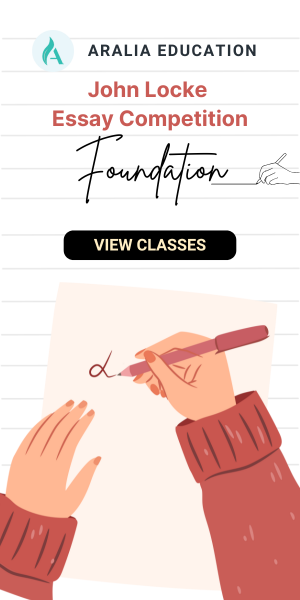在美國上高中,學生需要撰寫不同種類的論文作業。理解和掌握這些文章的寫作技巧,可以提前了解美高的寫作類型。今天,我們將向大家盤點5種常見的美國高中寫作論文類型:
Descriptive Essay 描述性散文
Narrative Essay 敘事散文
Expository Essay 說明文
Argumentative Essay 議論文
Analytical Essay 分析性論文
在本文中,我們將詳細介紹每一種類型並給出示例,非常適合未來將要前往美國讀高中的留學家庭參考。
高中階段想要快準狠提升英語能力?
Descriptive Essay 描述性散文
描述性文章要求作者生動地描述一些物體、人物、地點、經歷、情感、情況等,但更常見的是描述一些抽象的情感、經歷等。
描述性文章允許小作家們發揮創造力並自由表達,特別是當主題是關於他們個人和他們關心的事情時。例如,他們最喜歡的食物或他們的文化。
儘管聽起來很容易寫,但這種類型的文章通常將檢測作者做出適當用詞的能力。一篇描述性文章通常從介紹描述的主題或對像開始,然後給出一個整體的畫面,接著進入細節的描寫。
描述性散文範例(文章來自Yourdictionary)
I watched a thunderstorm, far out over the sea. It began quietly, and with nothing visible except tall dark clouds and a rolling tide. There was just a soft murmur of thunder as I watched the horizon from my balcony. Over the next few minutes, the clouds closed and reflected lightning set the rippling ocean aglow. The thunderheads had covered up the sun, shadowing the vista. It was peaceful for a long time.
I was looking up when the first clear thunderbolt struck. It blazed against the sky and sea; I could see its shape in perfect reverse colors when I blinked. More followed. The thunder rumbled and stuttered as if it could hardly keep up. There were openings in the cloud now, as if the sky were torn, and spots of brilliant blue shone above the shadowed sea.
I looked down then, watching the waves. Every bolt was answered by a moment of spreading light on the surface. The waves were getting rough, rising high and crashing hard enough that I could hear them.
Then came the rain. It came all at once and in sheets, soaking the sand, filling the sea. It was so dense I could only see the lightning as flashes of light. It came down so hard the thunder was drowned. Everything was rhythmic light and shadow, noise and silence, blending into a single experience of all five senses.
In an instant it stopped. The storm broke. The clouds came apart like curtains. The rain still fell, but softly now. It was as if there had never been a storm at all, except for a single signature. A rainbow, almost violently bright, spread above and across the water. I could see the horizon again.
Narrative Essay 敘事散文
敘事散文和描述性散文非常類似,但更側重於故事描述而不是對象描述。故事可以是關於作者的個人經歷、事件、故事等,作家甚至可以講述他們沒有經歷過的虛構經歷。敘事散文通常以第一人稱寫成。例如,高中生申請大學需要撰寫的個人陳述,就屬於這一類別。敘事散文的目的不僅是講述一個故事,而且還 強調經驗的重要性。因此,要寫出一篇完美的敘事文,作者必須在文章中包含背景設置、上下文、情節、結局和高潮等要素。
敘事散文範例(文章來自People’s Republic of Creativity)
Glup, glup.
I sat watching the plunger slowly make its way down the tube and into Miriam’s body. Inside the tube was a clear unknown liquid that would soon be injected into my own body. This was the third time this week, the twelfth time this month, and who knows how many times since we have been trapped in this hell on earth. Each day, we have only been given the bare minimum of food, water, and sleep. I don’t know how much longer we can survive before deemed useless by him.
Miriam fell out of her chair and onto the cold concrete floor, screaming in pain. She scrambles for something she can grasp onto to prop her malnourished body up. Then the piercing sound just suddenly stopped. Her thin arms that look only of bones and skin drop to the ground, and she lay still on the floor, as if she were…dead. Please don’t tell me she’s dead! No, she couldn’t be; we promised each other to live until the day of liberation.
She needs to live.
Tap, tap.
It was my turn. He walked over with a syringe full of what had just been injected into Miriam. I try to focus on the red, black, and white badge on his left arm instead of letting the fear crawl in and take over my brain. But the unsettling tension stirs my thoughts around and around.
“Twin A1387, let’s hope what happened to your sister doesn’t happen to you.” He smirked. The needle pierced through my skin and my body was suddenly aflame. The raging blaze spread through every one of my veins, until I was shrouded in darkness.
When I opened my eyes again, I found myself in an empty confinement. The space next to me, the space for Miriam, was empty too. Where was everyone? Most importantly, where was Miriam?
I got up and set my bare foot onto the dirty, wooden floor. Suddenly, my head started spinning and along with it, the world spun too. I fell to the ground, and when I could finally lift my head, what I saw above me terrified me. It was him, death in human form, and beside him were four of his helpers. They grabbed my arms and forced me to stand up.
“Good morning A1387. I am afraid your dear twin sister couldn’t handle the injections from yesterday. Let’s hope your fragile little limbs can endure those chemicals. I wonder how many more injections it will take for you to meet your pathetic sister,” he said, patting my head. His tone was playful, but deadly.
I froze. What? Miriam…dead? That one word, “twins”, has taken away everything of what feels like my past life, and now my last hope? I felt a surge of anger, hatred, sadness, fear, devastation swirling inside me like boiling lava in a volcano, ready to erupt. I wanted to scream, to shout, to kill him, but I couldn’t. My soft limbs felt as if they would collapse merely by trying to stand up. They would be harmless and defenceless against the Angel of Death. When he saw the hatred on my face, he started laughing hysterically and simply said, “What a shame; she was only 13. I cannot wait to see how long it will take for you to fall apart!”
Expository Essay 說明文
說明文要求學生調查一個想法,評估證據,闡述想法,並以清晰簡潔的方式提出關於該想法的論點。為此,作者需要運用對比、定義、舉例、因果等方法。作者不需要爭論或發表個人意見,而是要呈現平衡和組織良好的事實和數據。在一篇說明文中,作者需要通過提供足夠的信息來揭示所討論的特定主題。這是一篇內容豐富的文章,提供了對主題的平衡分析,基於真實的事實和數字。因此,這種文體通常測試學生對某個主題的熟悉程度和傳達信息的能力。
說明文範例(文章來自College Board SAT考試範本)
In response to our world’s growing reliance on artificial light, writer Paul Bogard argues that natural darkness should be preserved in his article “Let There be dark”. He effectively builds his argument by using a personal anecdote, allusions to art and history, and rhetorical questions.
Bogard starts his article off by recounting a personal story – a summer spent on a Minnesota lake where there was “woods so dark that [his] hands disappeared before [his] eyes.” In telling this brief anecdote, Bogard challenges the audience to remember a time where they could fully amass themselves in natural darkness void of artificial light. By drawing in his readers with a personal encounter about night darkness, the author means to establish the potential for beauty, glamour, and awe-inspiring mystery that genuine darkness can possess. He builds his argument for the preservation of natural darkness by reminiscing for his readers a first-hand encounter that proves the “irreplaceable value of darkness.” This anecdote provides a baseline of sorts for readers to find credence with the author’s claims.
Bogard’s argument is also furthered by his use of allusion to art – Van Gogh’s “Starry Night” – and modern history – Paris’ reputation as “The City of Light”. By first referencing “Starry Night”, a painting generally considered to be undoubtedly beautiful, Bogard establishes that the natural magnificence of stars in a dark sky is definite. A world absent of excess artificial light could potentially hold the key to a grand, glorious night sky like Van Gogh’s according to the writer. This urges the readers to weigh the disadvantages of our world consumed by unnatural, vapid lighting. Furthermore, Bogard’s alludes to Paris as “the famed ‘city of light’”. He then goes on to state how Paris has taken steps to exercise more sustainable lighting practices. By doing this, Bogard creates a dichotomy between Paris’ traditionally alluded-to name and the reality of what Paris is becoming – no longer “the city of light”, but moreso “the city of light…before 2 AM”. This furthers his line of argumentation because it shows how steps can be and are being taken to preserve natural darkness. It shows that even a city that is literally famous for being constantly lit can practically address light pollution in a manner that preserves the beauty of both the city itself and the universe as a whole.
Finally, Bogard makes subtle yet efficient use of rhetorical questioning to persuade his audience that natural darkness preservation is essential. He asks the readers to consider “what the vision of the night sky might inspire in each of us, in our children or grandchildren?” in a way that brutally plays to each of our emotions. By asking this question, Bogard draws out heartfelt ponderance from his readers about the affecting power of an untainted night sky. This rhetorical question tugs at the readers’ heartstrings; while the reader may have seen an unobscured night skyline before, the possibility that their child or grandchild will never get the chance sways them to see as Bogard sees. This strategy is definitively an appeal to pathos, forcing the audience to directly face an emotionally-charged inquiry that will surely spur some kind of response. By doing this, Bogard develops his argument, adding gutthral power to the idea that the issue of maintaining natural darkness is relevant and multifaceted.
Writing as a reaction to his disappointment that artificial light has largely permeated the presence of natural darkness, Paul Bogard argues that we must preserve true, unaffected darkness. He builds this claim by making use of a personal anecdote, allusions, and rhetorical questioning.
Argumentative Essay 議論文
議論文類似於說明文,它要求作者提出基於證據的論點。作者必須提出論文陳述,收集和評估證據,並就該主題確立立場。許多人認為議論文和說明文是同一種類型,但其實不然。議論文比說明文需要更多的研究,議論文通常用於一門課程的最終項目,需要足夠時間和詳細的研究。論文分為三個部分:引言、正文和結論。引言有主題和論文陳述,正文有證據和論點,結論總結了論點和未來研究的潛在方向。
议论文示例(文章来自ETS GRE写作考试示例)
Prompt: The best ideas arise from a passionate interest in commonplace things.
Discuss the extent to which you agree or disagree with the statement above and explain your reasoning for the position you take. In developing and supporting your position, you should consider ways in which the statement might or might not hold true and explain how those considerations shape your position.
Answer:
Passion is clearly necessary for a truly great idea to take hold among a people—passion either on the part of the original thinker, the audience, or ideally both. The claim that the most lucrative subject matter for inspiring great ideas is “commonplace things” may seem initially to be counterintuitive. After all, aren’t great ideas usually marked by their extraordinary character? While this is true, their extraordinary character is as often as not directly derived from their insight into things that had theretofore gone unquestioned. While great ideas certainly can arise through seemingly pure innovation… say, for example, Big Bang cosmology, which developed nearly all of its own scientific and philosophical precepts through its own process of formation, it is nevertheless equally true that such groundbreaking thought was, and is, still largely a reevaluation of previous assumptions to a radical degree… after all, the question of the ultimate nature of the universe, and man’s place in it, has been central to human thought since the dawn of time.
Commonplace things are, additionally, necessary as material for the generation of “the best ideas” since certainly the success among an audience must be considered in evaluating the significance and quality of an idea.
The advent of Big Bang cosmology, which occurred in rudimentary form almost immediately upon Edwin Hubble’s first observations at the Hooker telescope in California during the early 20th century, was the most significant advance in mankind’s understanding of the universe in over 400 years. The seemingly simple fact that everything in the universe, on a very large scale, is moving away from everything else in fact betrays nearly all of our scientific knowledge of the origins and mechanics of the universe. This slight, one might even say commonplace, distortion of tint on a handful of photographic plates carried with it the greatest challenge to Man’s general, often religiously reinforced, conception of the nature of the world to an extent not seen since the days of Galileo. Not even Charles Darwin’s theory, though it created more of a stir than Big Bang cosmology, had such shattering implications for our conceptions of the nature of our reality. Yet it is not significant because it introduced the question of the nature of what lies beyond Man’s grasp. A tremendous number of megalithic ruins, including the Pyramids both of Mexico and Egypt, Stonehenge, and others, indicate that this question has been foremost on humankind’s collective mind since time immemorial. Big Bang cosmology is so incredibly significant in this line of reasoning exactly because of the degree to which it changed the direction of this generally held, constantly pondered, and very ancient train of thought.
Additionally, there is a diachronic significance to the advent of Big Bang cosmology, which is that, disregarding limitations such as the quality of optical devices available and the state of theoretical math, it could have happened at any point in time. That is to say, all evidence points to roughly the same raw intellectual capacity for homo sapiens throughout our history, our progress has merely depended upon the degree of it that a person happens to inherit, a pace that has been increasing rapidly since the industrial revolution. Yet this discovery had to happen at a certain point in time or another—it cannot have been happening constantly or have never happened yet still be present—and this point in time does have its own significance. That significance is precisely the fact that the aforementioned advent must have occurred at precisely the point in time at which it truly could have occurred—that is to say, it marks the point in our history when we had progressed sufficiently to begin examining, with remarkable substantiated acuity, the workings of the universe across distances that would take millions of human lifetimes to reach or to traverse. The point for the success of this advent must necessarily have been, additionally, the point at which the audience concerned was capable and prepared to accept such a radical line of reasoning.
Both factors, a radical, passionate interpretation of the commonplace and the preparedness to accept such an interpretation, are necessary for the formulation of a truly great idea. If the passion is absent from an inquiry by the thinker or by the bulk of an audience, the idea will die out if it comes to fruition at all. If the material is not sufficiently commonplace to be considered by an informed audience of sufficient size, the same two hazards exist. Given these two factors, the idea must still be found palatable and interesting by the audience if it is to hope to gain a foothold and eventually establish itself in a significant fashion.
由美國頂尖名師領銜的國高中線上課堂
Analytical Essay 分析性論文
對主題進行深入分析的寫作類型。分析性論文可以提高作者的寫作技巧和對主題的整體理解,同時幫助讀者更多地了解這些重要的主題。這種類型的文章不是為了說服讀者接受某種觀點,而是為讀者提供全面、全面的分析。分析論文在GRE考試的寫作部分很常見。一篇好的分析性論文包括一個陳述主要論點的論文陳述,接著是對支持它的證據的分析。
分析性論文示例
文章完整版請參考鏈接:https://docs.google.com/document/d/e/2PACX-1vTYNPTTE38TlywH9tU3nKTZSK7lI3MH11HTsoIOLKLPXpXKr3vN12DG6vE/pub
No matter how much money people are willing to pay for health care, they may still suffer terribly from incurable diseases such as AIDS and cancer because of the underdevelopment of medical technology. However, today, the advancement in human knowledge has led to the introduction of human gene-editing, turning impossibility to possibility. In particular, the recent technology for genome editing called CRISPR has been having a groundbreaking impact on research in genetic science. This is due to its remarkable potential to simply cure genetic diseases in an embryo before they have a serious effect on further developmental progression. Although currently, there have been numerous debates regarding its extension in research for widespread uses, CRISPR is a completely promising technology because of the benefits it brings to people.
CRISPR, or Clustered regularly interspaced short palindromic repeats, is the newest innovation in genetic engineering. The way CRISPR works is similar to “the scissor-like action of Cas 9 to target… any specific DNA sequence” (Baylis and Rossant). By making cuts in specific locations in DNA, CRISPR can cure diseases and make alterations in an embryo’s DNA, which prevent diseases from being passed down to following generations (Baylis and Rossant). Throughout the history, governments and researchers came up with different approaches politically and scientifically in attempt to control population. They hoped to encourage the “richest, wisest and healthiest to breed like rabbits” and the “sick, stupid, and poor to take one for the empire and remain childless” (Comfort 28). The second attempt happened during the 20th century, when the U.S government passed the law preventing marriage and immigration that would threaten a perceived core American “stock.” Another more extreme example was when Nazi sterilization law further advanced this population control approach. Later in the century, a biotechnological approach was established as a safer and more humane way to manage population health (qtd in Comfort 28). “Gene surgery,” which is similar to CRISPR technology, was established and followed by contentious debates regarding ethical issues between disease treatment and human trait enhancements. Currently, there has been a halt in the use of CRISPR because of the increase in concern from the public about the pros and cons of this technology.










